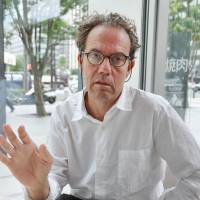Jose Maria Sicilia, an eminent Spanish modern artist, is holding an exhibition in Fukushima of works inspired by the sounds produced by the March 2011 earthquake and tsunami disasters.
In an interview in Tokyo, Sicilia, 59, said he wanted to give form to victims' feelings of "being lost and speechless."
His works for the exhibition, titled "Fukushima Winterflowers," include a set of more than 30 tapestries hanging from the ceiling, which he created based on the sounds of the tsunami.
Also being displayed is a bronze object he produced by digitizing and processing into three dimensions the voice of Miki Endo, an official of the Minamisanriku town office in Miyagi Prefecture who continued to warn residents about the tsunami until the waves swept her away.
Among works particularly drawing visitors' attention are paintings and clay objects he made with kindergartners and elementary school children who experienced the disasters.
In the venue, visitors can hear the voices of these children and teachers talking about their terrible experiences and unforgettable memories.
Sicilia said he was amazed to see that the children had no fear about producing objects to represent the tsunami.
He said he is sure that "these children can rebuild (their hometown) more beautifully, more strongly and more wisely (than anyone else)."
Sicilia said visitors have told him that his works have helped "sublimate the earthquake as art" and "warmed" their hearts.
A native of Madrid, Sicilia came to Japan for the first time in 1988. Though he has organized exhibitions in Nagasaki, Kyoto and elsewhere, he had not heard of Fukushima until the disasters struck.
Sicilia named the exhibition "Winterflowers" after "Summer Flowers," a novel by Tamiki Hara (1905-1951) based on his experience of the 1945 atomic bombing of Hiroshima.
The exhibition at the Fukushima Prefectural Museum of Art runs until Sunday.



